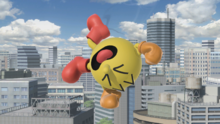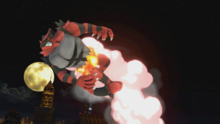Tumbling: Difference between revisions
(→Trivia: It wasn't fixed. I have heard this before myself. A good way to test this is in Temple, New Pork City or Palu's Temple.) |
No edit summary Tag: Mobile edit |
||
| Line 46: | Line 46: | ||
*Whenever {{SSBB|Wolf}} is in tumbling animation, his left arm will detach from his elbow. This can be clearly seen when pausing the game. This was later fixed in ''Ultimate''. | *Whenever {{SSBB|Wolf}} is in tumbling animation, his left arm will detach from his elbow. This can be clearly seen when pausing the game. This was later fixed in ''Ultimate''. | ||
*Characters' facial expressions when tumbling has changed over the series, in ''Smash 64'' and ''Brawl'', every character will have a wincing look on their face, while in ''Melee'', ''Smash 4'', and ''Ultimate'' characters will have a more surprised look besides [[Mr. Game & Watch]]. | *Characters' facial expressions when tumbling has changed over the series, in ''Smash 64'' and ''Brawl'', every character will have a wincing look on their face, while in ''Melee'', ''Smash 4'', and ''Ultimate'' characters will have a more surprised look besides [[Mr. Game & Watch]]. | ||
*In ''Smash 4 | *In ''Smash 4'', when [[Meta Knight]] goes into his reeling animation, he will grunt twice. | ||
*In ''Ultimate'', being hit and put in tumble will not make the victim face the attacker, and they will instead remain in the direction they were facing before the hit. This was not present in previous games. | *In ''Ultimate'', being hit and put in tumble will not make the victim face the attacker, and they will instead remain in the direction they were facing before the hit. This was not present in previous games. | ||
*In {{forwiiu}}, a character's tumbling animation will play in reverse if they are sent into their tumbling animation after bouncing off a wall. | *In {{forwiiu}}, a character's tumbling animation will play in reverse if they are sent into their tumbling animation after bouncing off a wall. | ||
Latest revision as of 20:21, October 16, 2024
Tumbling (or DamageFall internally in Melee onwards) is an airborne state that a character may enter after being hit or pushed in certain ways; for example, edge slipping can cause a character to tumble. A tumbling character can easily be identified by their defensive, rotating animation. Characters may tumble after being hit through the air by an attack with strong enough knockback, footstooled in midair, pushed off a ledge, after walking off an edge while carrying a crate or other heavy item, or by sliding off of an edge while shielding.
In the original Super Smash Bros., the minimum knockback that must be inflicted to cause tumbling is roughly 60 units and in later games, this would be increased to around 80 units.
The benefit from tumble compared to non tumble hitstun varies from game to game. In Smash 64 and Super Smash Bros. Melee, tumble is not beneficial because it leaves the opponent in more hitstun than a non tumble state. In Super Smash Bros. Brawl however, tumble leaves the opponent at a bigger advantage than a non tumble state. Tumble enables the opponent to perform hitstun cancelling (and subsequently momentum cancelling) which is not possible in a non tumble state. It also enables the opponent to DI which they cannot do from non tumble hitstun starting from Brawl and the gravity penalty also now takes effect once the opponent enters tumble. This enables characters with high gravity (such as Fox) to fly much higher once they enter tumble preventing chain grabs and strings to connect against them. In Super Smash Bros. 4, hitstun cancelling's effect was greatly reduced making tumble less beneficial than in Brawl although it still has the same advantages besides hitstun cancelling. With Super Smash Bros. Ultimate homogenising the effect of falling speed and gravity against moves with an angle between 70°-110°, tumble has become less beneficial again although it still enables the opponent to DI.
Actions possible while tumbling[edit]
Tumbling is not the same state as helplessness; after hitstun ends, tumbling characters can carry out most normal airborne actions while tumbling:
- They can move horizontally through the air as per normal.
- They can perform aerial attacks, use any remaining jumps, and use any special moves, all of which end the tumbling state.
- In Brawl, Smash 4 and Ultimate, air dodging can also be performed as per normal and will end tumbling—this was not possible in Melee. It is not possible to use a grab aerial while tumbling, though, as attempting to do so results in an air dodge (aerial attack in SSB4); this was changed in Ultimate, however, so any character with a grab aerial can now use said move out of tumbling.
- In Melee and Brawl, they can end the tumble and resume their normal aerial state by tapping horizontally on the Control Stick.
- They can tech if they are about to hit a platform. In Brawl and SSB4, if the tumbling was caused by a footstool jump, however, there is a short period during which the character cannot tech; this was changed in Ultimate so that characters can always tech if they land after getting footstooled.
- They can still grab ledges as usual. In Melee, they can tech on them if facing the opposite side, and canceling a tumbling state by grabbing a ledge awards the Life on the Edge bonus, which gives 800 points for each time this is achieved.
- In Smash 64 and Melee, they can fast fall while in their tumbling state.
If tumbling characters hit the ground without teching, they will land into a lying position and must then use a floor recovery. Characters undergo a flopping animation upon hitting the ground before they can use their floor recovery, leaving them vulnerable for a short while.
The tumbling animation is used after a shield jump, though no action can be performed during this time. It is also used at the end of Olimar's Final Smash (after emerging from the Hocotate Ship), but Olimar will be unable to do anything other than move horizontally.
Reeling[edit]
Reeling (known as DamageFlyRoll internally) is an alternate hitstun state characters can experience if hit by a move with enough knockback to cause tumbling, denoted by their helix motion while flying. In all games, reeling has a 30% chance of occuring, and only if the target has at least 100% damage; this is checked after they get hit, so a tumble-inducing attack that brings them from below 100% damage to that amount or higher can cause reeling as well.
Reeling's differences from the usual knockback animation are only aesthetic, though due to the change in animation shifting the character's hurtboxes, it can rarely cause them to get hit by attacks that would have otherwise missed, or vice versa. The exception to this is in Smash 4, where reeling reduces hitstun inflicted on the target by one frame, and prevents them from teching on the ground until their hitstun cancel window starts. While the former difference is negligible, the latter effectively gives characters a random chance to be unable to avoid a knockdown, allowing for certain KO setups, such as Fox's forward tilt or neutral aerial into an up smash. However, and only in Smash 4 as well, reeling allows Cloud to tech walls and ceilings if he is hit near the apex of Climhazzard, where teching is otherwise impossible. In Ultimate, these discrepancies are removed, causing reeling's differences from the standard pre-tumble animation to be purely aesthetic again (aside from hurtbox placement), and it additionally cannot happen if a character is launched from behind.
Due to his two-dimensional nature, Mr. Game & Watch has a unique reeling animation, spinning in a cartwheeling motion instead of a spiraling motion. Steve also has a unique reeling animation, which is just his tumbling animation with his body oriented in the direction of his knockback.
Some attacks in later games are capable of forcing reeling regardless of the target's damage percentage, namely the tornadoes in Hyrule Castle (from Smash 4 onward) and PictoChat 2, as well as the Mii Swordfighter's Gale Strike in Ultimate. The Bullet Bill item also puts characters in state similar to reeling after its use; however, it does not end naturally, and can be canceled with an aerial attack, an air dodge, or by landing.
Gallery[edit]
Yoshi tumbling in Super Smash Bros.
Jigglypuff tumbling in Melee.
Marth tumbling in Brawl.
Falco reeling as a result of a sweetspotted Wolf Flash in Brawl.
Mr. Game & Watch tumbling in for Nintendo 3DS.
Palutena reeling in for Nintendo 3DS.
Trivia[edit]
- The animation for tumbling is the same used in the character's Star KO animation, as well as the Screen KO in Smash 64, Melee (right before they hit the screen) and Brawl.
- A unique tumbling animation is used for characters who are footstooled in midair. This same animation is also used for when characters enter doors in midair.
- Whenever Wolf is in tumbling animation, his left arm will detach from his elbow. This can be clearly seen when pausing the game. This was later fixed in Ultimate.
- Characters' facial expressions when tumbling has changed over the series, in Smash 64 and Brawl, every character will have a wincing look on their face, while in Melee, Smash 4, and Ultimate characters will have a more surprised look besides Mr. Game & Watch.
- In Smash 4, when Meta Knight goes into his reeling animation, he will grunt twice.
- In Ultimate, being hit and put in tumble will not make the victim face the attacker, and they will instead remain in the direction they were facing before the hit. This was not present in previous games.
- In Super Smash Bros. for Wii U, a character's tumbling animation will play in reverse if they are sent into their tumbling animation after bouncing off a wall.
- In Ultimate, the same effect happens whenever a character goes into their tumbling animation from an attack from behind, a low-hitting attack, or gets meteor smashed with their damage at 100% or more.
- Steve's tumbling animation is identical to his running animation, as a reference to the damage animations in Minecraft. As it is identical to his animation when moving laterally in the air, knowing when to tech with the character can prove difficult.
- Kirby's tumbling animation is likely a reference to his falling animation when he loses a life in his home series.







